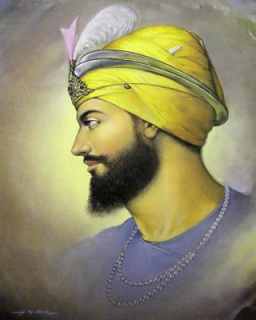SAPTSRING : THE 'SEVEN PEAKS' WHICH SURROUND HEMKUNT


In 'Bachitar Natak' the Guru Gobind Singh relates his story in the following words-
I shall now relate my own story, how God sent me into this world. I was busy performing penance on the hills of 'Hemkunt' where seven peaks are prominent. The place is called 'Sapt Sring’ where King Pandu had performed Yoga, there I practiced austerity and worshipped the god of death.” The Guru Ji tells us about his previous incarnation, that in the Himalayan range, where there is Sapt Sring Mountain, on that hill he meditated the Name of God. In his meditation when he became one with God, then the Almighty ordained him to take birth in India in order to crush the cruel rulers. "My father and mother meditated on the incomprehensible. They both practiced the highest yoga through diverse spiritual efforts. Their devout service in the love of God pleased the Almighty who commanded me to take human form in this world. I did not like to come. God sent me into the world with a mandate saying, 'I cherish thee as my son and send thee to establish the path of truth. Go into the world and establish virtue and keep the people, away from evil.' When my father came to Triveni (Allahabad) he daily devoted himself to meditation and charity. There at Allahabad the dazzling light manifested itself into human form."
Discovery and Construction of Gurudwara Hemkund Sahib Hemkund (Hemkunt) Sahib is a holy shrine of the Sikhs. This sacred Gurudwara is situated at an elevation of 4,329 mts above sea level in a place called Lokpal, in the Chamoli district of Uttarakhand. This gurudwara is associated with the tenth guru of Sikhs, Guru Govind Singh. Literal meaning of the word Hemkund is a pond of now (“Hem” means snow and “Kund” or “Kunt” denotes a pond or Lake). The lake in Hemkund Sahib is surrounded by the seven mountain peaks and each peak is embellished by a Nishan Sahib on its cliff. These all peaks together are known as the Sapt – Sring. There is no direct road for Hemkund Sahib. Devotees trek 15 km from Gobindghat. There is a Lakshman Temple behind the gurudwara, dedicated to younger brother of Lord Ram, who practiced meditation here for many years. History The mythology of this place comes into light from the time of the tenth guru of Sikhs. The complete history of this place is described in Bachitira Natak , the autobiography of Guru Gobind Singh. In Bachitira Natak Shri Guru Gobind Singh Ji describes a powerful youth who was called into existence during Satyug, the ‘era of truth’ (the first of four ages according to Hindu tradition) to do battle with fierce demons that terrorized mortals and gods including Hindu deities and demi-gods. When they had been destroyed, the youth, known as Dusht Daman, the ‘destroyer of evil’, was instructed to go to Hemkunt Sapt – Sring to meditate until he was called upon by God. Guru Gobind Singh’s own account in Bachitra Natak completes this story. After realizing his oneness with God through meditation and austere discipline, he was reborn in Kal Yug, the ‘age of darkness’, as the son of the Sikh’s ninth Guru Teg Bahadur and his wife Mata Gujri. Later, after his father’s martyrdom, he became the tenth and final Guru of the Sikhs in the tradition.
Although Bachitra Natak was included among the Dasam Granth in the 1730s, Sikhs apparently did not consider looking for Hemkunt Sapatsring until the late nineteenth century. It did not become a place of pilgrimage until the twentieth century. Pandit Tara Singh Narotam, a nineteenth century Nirmala scholar, was the first Sikh to trace the geographical location of Hemkunt. He wrote of Hemkunt Sahib as one among the 508 Sikh shrines he described in Sri Gur Tirath Sangrah (first published in 1884). Much later, renowned Sikh scholar Bhai Veer Singh was instrumental in developing Hemkunt Sahib after it had been, in a sense, re-discovered by another Sikh in search of the Guru’s tap asthan.
Sohan Singh was a retired granthi from the Indian army who was working in a gurdwara in Tehri Garhwal. In 1932, he read the description of Hemkunt Sahib in Bhai Vir Singh’s Sri Kalgidhar Chamatkar (1929). He read about the meditation of a great yogi there based on the tale of Guru Gobind Singh’s life and previous life as told in Bachitra Natak and the Suraj [Prakash] Granth. In 1930, Sant Sohan Singh, claimed to have discovered Hemkunt Sahib as stated in Bachitra Natak.
Sant Sohan Singh wanted to spread the news of his discovery but none wanted to hear it and it practically fell on deaf ears. The Gurduwara committee of Mussourie, the closest town to the shrine in Uttarkhand was very skeptical as were the Shiromani Gurudwara Parbandhak Committee – nobody would listen. He then decided to contact Bhai Vir Singh Ji. In 1934 Sohan Singh met Bhai Vir Singh and convinced him that he had found Hemkunt Sahib. Bhai Vir Singh offered his help to develop the site of Hemkunt Sahib. He gave Sohan Singh funds to buy material and construct a Gurudwara on the shores of the lake. Sohan Singh was accompanied by a Havaldar (army sergeant) called Modan Singh who had offered his services. A year later both of them set off again. They got a local building contractor to start the construction of the gurudwara after obtaining local permissions. Thus was established the celebrated shrine of Hemkunt Sahib.
